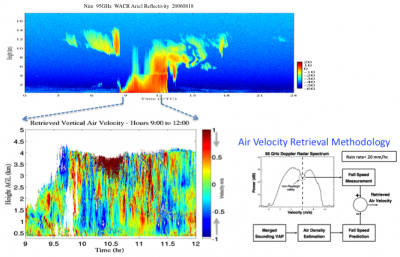Vertical Air Motion Profiles Available Through New Value-Added Product
Published: 11 March 2013

The VERVELSR VAP operates by exploiting a resonance effect that occurs in non-Rayleigh (Mie) backscattering, under conditions of moderate stratiform rain. Air motion is retrieved through examination of the velocity spectra, such that falling drops are represented in the spectra according to their fall velocities due to size sorting by air density. The air velocity is measured as the velocity of very small droplets known to follow the air motion. The first minimum in the principal peak is where the resonance effect takes place and is mapped to represent droplets in the 1.65 mm size range. These droplets are known to have a terminal fall velocity of about 5.8 ms-1, depending on the air density, and serve as a relative reference point.
In VERVELSR, air density is calculated using data from the MERGESONDE VAP. The difference between the known terminal velocities (adjusted for air density) and the observed velocity in the Doppler spectra yields an estimate of the mean vertical air velocity. The retrieval is applied only to periods of liquid phase precipitation. In addition, in an effort to provide a robust algorithm, certain criteria have been applied to mitigate potential contaminants related to ice/melting layer, turbulence, or heavy rain.
VERVELSR is currently in evaluation mode, and any comments on the data set are welcome. Evaluation data are available for a few days from the Southern Great Plains (SGP) site and the ARM Mobile Facility Niamey (NIM) deployment. The VAP will run autonomously when the evaluation is completed. More information is available at the VAP web page and in the README file that accompanies the data files in the Data Archive’s evaluation area.
To access these data, log in to the Data Archive. (Go here to request an account.)
The ARM Climate Research Facility is a DOE Office of Science user facility. The ARM Facility is operated by nine DOE national laboratories, including .
Keep up with the Atmospheric Observer
Updates on ARM news, events, and opportunities delivered to your inbox
ARM User Profile
ARM welcomes users from all institutions and nations. A free ARM user account is needed to access ARM data.


















